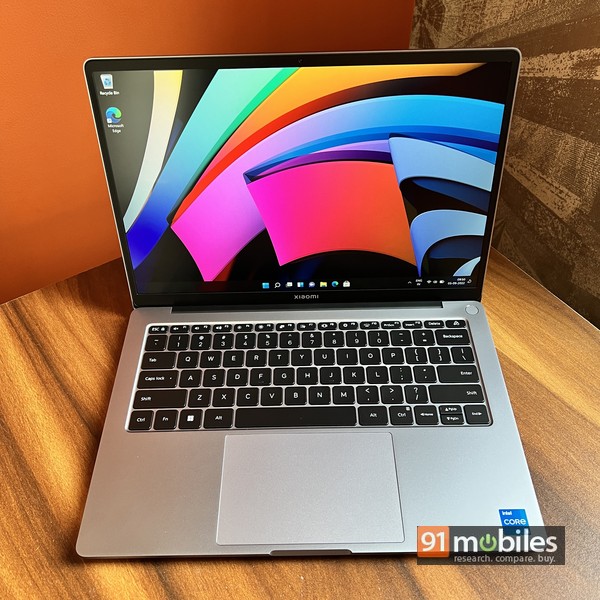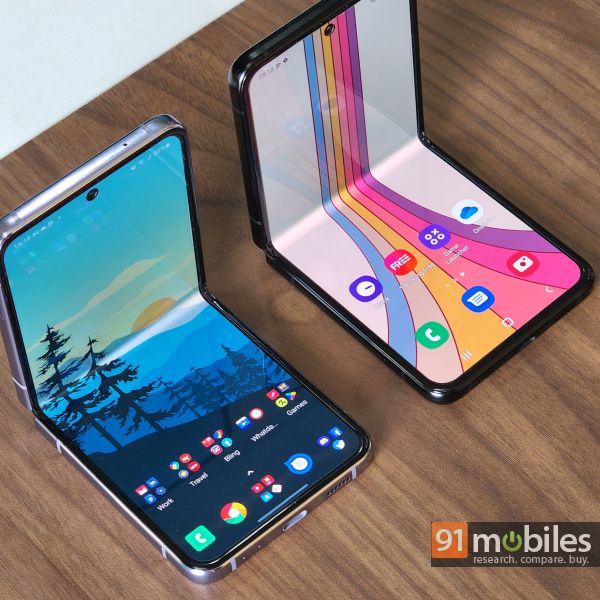
LCD and AMOLED are the two most common displays found on consumer electronics, including smartphones, tablets, wearables, TVs, and more. Both are equally impressive in their own unique ways, but there are stark differences between the two panels in the way they display content. In this article, we will take a look at those differences, shedding light on the underlying technology of LCD and AMOLED, as well as compare their strengths and weaknesses. So, without any further ado, let’s get started.
Table of Contents
LCD vs AMOLED display technology

LCD stands for liquid crystal display. As the name would suggest, LCDs are made possible by liquid crystals. These liquid crystals are ‘twisted’ in nature. An electric charge is applied to untwist/change their orientation to varying degrees to allow the various colours of light to pass through, which helps produce images.
To produce colour, LCDs use red, green, and blue shade filters, which together form pixels. Each subpixel in an LCD can produce up to 256 shades when varying levels of voltage are applied. One of the highlighting things about the LCDs is that they always need a backlight to produce images. This is why they cannot efficiently produce true blacks, as the presence of a backlight always produces greyish blacks.

AMOLED (active matrix organic light-emitting diode), on the other hand, uses OLED as the base technology. Current is applied to the individual anode and cathode conductors of the LED to produce visible light. Each pixel usually contains three subpixels, red, green, and blue, which turn on and off in a pattern to produce a wide range of colours.
AMOLED panels don’t need a backlight like LCDs, as each LED can produce its own light. And as explained, AMOLED panels use an active matrix of pixels that uses storage capacitors to store charge between refresh cycles. This makes them consume even less power as each pixel holds the charge until the next refresh cycle.
Additionally, AMOLED displays have deeper blacks, brighter whites, and an essentially infinite contrast ratio. This makes the display an excellent choice for producing vibrant images. In fact, AMOLED display tech is the best display technology we currently have.
LCD vs AMOLED display types
| LCD | AMOLED |
| TN | Super AMOLED |
| VA | pOLED |
| IPS |
LCD
There are mainly three types of LCD displays, TN, VA, and IPS. All these displays have a thin-film transistor aka TFT, which controls the voltage of each pixel in an LCD so that they retain their charge between refresh cycles. It further improves the overall image quality, as well as contrast level and response time. Let’s dive into details of the LCD display types:
1. TN
Twisted nematic or TN panels are a popular type of LCD display and are one of the earliest types of LCD display technology. In a TN display, liquid crystals twist 90 degrees when the current is applied, allowing the light to pass through. These panels are cheaper to produce and gamers especially prefer them for their fast response times and refresh rates.

However, TN displays suffer from poor colour reproduction quality when viewed from the off-axis i.e. from the sideways.
| Pros | Cons |
| Cost-effective | Viewing angles are not good |
| Fast response time and refresh rate |
2. VA
VA, or vertical alignment LCD displays, as the name suggests, have vertically aligned crystals in the pixels that allow the light to pass through. VA panels have good colour reproduction and wide viewing angles compared to TN panels. VA panels also have similar high response times as the TN panels but suffer from low brightness issues.
| Pros | Cons |
| Better colour reproduction than TN panel | Low brightness issues |
| Better viewing angle |
3. IPS

IPS or in-plane switching displays are yet another type of LCD display in the market and one of the most popular display types found in consumer electronics. In an IPS panel, liquid crystals rotate parallel or in-plane and are aligned parallel to the glass substrate to allow the light to pass through. The IPS technology was developed by Hitachi Ltd in 1996 to solve the colour reproduction and viewing angle issues present in TN displays.

Today, the IPS panels are widely used in smartphones, TVs, laptops, and other consumer electronic devices. They offer excellent contrast ratio, colour reproduction, brightness, and the widest viewing angles compared to any other type of LCD. For this reason, they can be found on many high-end consumer electronic devices. Not to mention IPS panels are cheaper to produce and the best display tech available today for professionals compared to the next best display type — OLED.
However, IPS panels suffer from lower refresh rates compared to TN panels, but manufacturers continue to improve on this front as the technology matures.
| Pros | Cons |
| Better contrast ratio, colour reproduction, brightness | Lower refresh rate than TN panel |
| Wide viewing angles | |
| Cheaper to produce |
AMOLED display types
AMOLED displays have amazing energy efficiency and even flexible properties as well as excellent colour reproduction, contrast ratio, and viewing angle which makes them the best display technology available today. AMOLED displays are available in two types. Let’s explore them.
Super AMOLED

Super AMOLED displays are basically AMOLED displays with a touch-sensitive layer built into them. It is not a new display technology in and of itself as it is still based on AMOLED tech. Mainly Samsung uses the term ‘Super AMOLED’ to market its AMOLED panels. The integrated touch-sensitive layer is used to control the AMOLED display. Samsung also makes Dynamic AMOLED displays with improved HDR10+ certification and brightness.
| Pros | Cons |
| Thin and light | Expensive production technique |
| Excellent viewing angles | Burn-ins |
| Deep blacks |
POLED
POLED, or polymer organic light-emitting diode uses a glass substrate in the construction of OLED displays to make them flexible. Traditionally, a glass substrate was used to build OLED displays, including AMOLED panels. But modern technology allows making use of plastic substrates to make POLED possible. POLED technology is the magic behind the bendable/rollable electronics you see these days. One of the things to note here is that it is entirely possible to make bendable AMOLED displays by using plastic substrates instead of glass substrates.

The POLED tech brings new advantages to the table, such as thinner and more durable displays in electronics. These are also more shock-resistant compared to other display types, thanks to the usage of plastic substrates. POLED technology also makes thinner bezel electronics possible, as critical electronics components can be embedded beneath a rolled POLED display.
All the AMOLED displays are produced by Samsung Displays and LG Displays. LG markets its bendable displays as pOLED.
| Pros | Cons |
| More durable than AMOLED | Poor outdoor visibility |
| Shock-resistant | Vulnerable to damages |
| Higher screen-to-body ratio |
LCD vs AMOLED advantages and disadvantages
LCDs are a cost-effective way to bring excellent image quality to a wide range of electronics. They are generally found both on affordable and high-end devices. With that said, AMOLED panels really take each aspect of the LCD display to the next level, offering a greater level of contrast, deeper blacks, extremely fast response times, higher colour saturation, and more. Let’s check out the advantages and disadvantages of both panels:
LCD
| Advantages | Disadvantages |
| Bright | Low contrast ratio |
| Affordable | Greyish blacks |
| No burn-in | Limited viewing angles |
| Higher lifespan | Slower response time |
| Restricted colour gamut |
AMOLED
| Advantages | Disadvantages |
| Bright | Costly |
| Infinite contrast ratio | Burn-in |
| Deep blacks | Degrades over time |
| Wide viewing angles | Perceived low resolution at 720p |
| Faster response times | |
| High HDR accuracy |
LCD vs AMOLED: Verdict
Considering AMOLEDs offer improvements in image quality across the board it is a clear winner here. The panel will be an excellent choice for consuming multimedia content. LCD, on the other hand, is still an advanced display technology and is being improved with the latest technologies such as mini-LEDs and QLEDs. The mini-LEDs really take things to the next level by offering wider colour saturation and improved blacks levels that are comparable to OLEDs.
FAQs
1. What are LED LCD TVs?
LED LCDs, also known as LED-backlit LCD TVs, are your usual LCD TVs using a LED backlight. The use of a LED backlight makes traditional LCD displays more power efficient. Manufacturers commonly call them LED TVs instead of LED-backlit LCDs or LED LCDs to not confuse the consumers.
2. What is a QLED TV?
In a QLED or quantum dot LED TV, a quantum layer is used to offer higher levels of brightness and more colour-accurate LCD displays. QLED TVs also usually come with HDR compatibility due to the higher brightness levels. Lastly, they are also immune from OLED burn-in.
3. What’s mini-LED?
Mini LED or mini LED is the newest LCD technology in the market. It is used to enhance the brightness and colour saturation of LCDs even further. A mini-LED uses a series of small diodes as a backlight. Each diode used in the mini-LED can produce a wide range of colours for each subpixel instead of just one colour that the traditional backlight offers (usually blue). Because LEDs are smaller in nature, mini-LEDs offer greater black levels (comparable to AMOLEDs), as less light bleeds through the pixels. Mini LEDs also offer greater local dimming capabilities compared to traditional LCDs as each black zone can be intricately controlled as there are so many mini LEDs present in any given space. Lastly, mini LEDs are affordable to produce.















